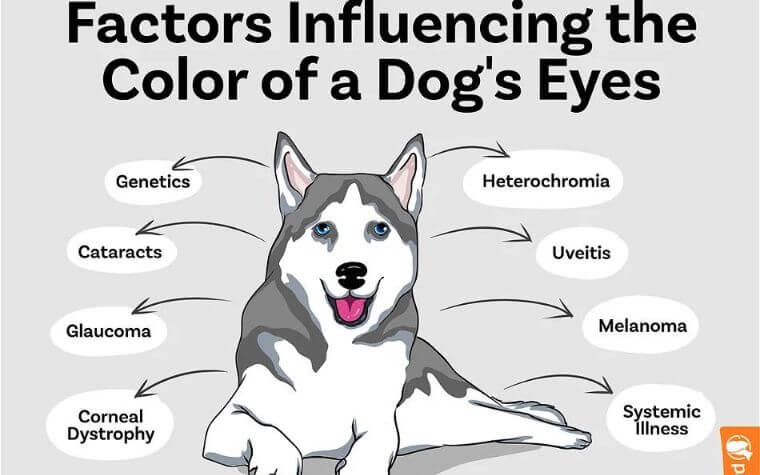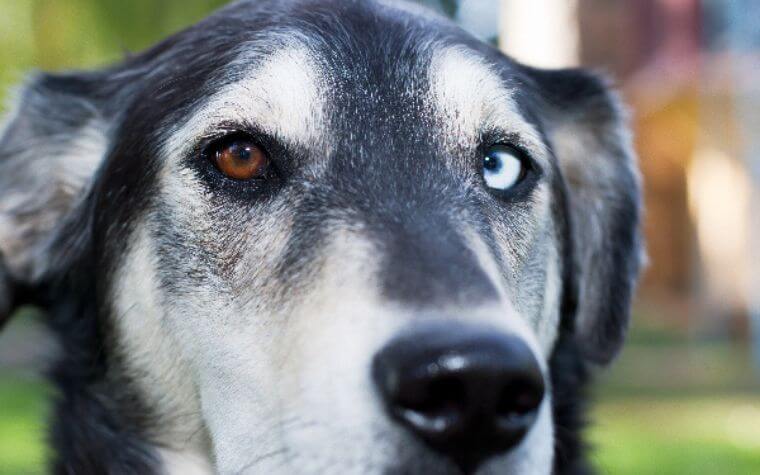There is a huge variety of dog breeds, and each one is distinctive in its way. Not only can they have distinct physical characteristics and coat colors, but they can also have varied eye colors in the Dog Eye Color Chart.
Dogs can also have stunning eye hues that simply take your breath away, just like us humans. The dog eye color chart is a fantastic collection of captivating tones, ranging from ice blue to traditional brown.
What Influences a Dog’s Eye Color?

While discussing all of the naturally occurring dog eye colors, the iris color of the dog is typically included.
The colorful membrane that encircles the eye’s pupil is the iris. Together with pigment granules, the iris tissue also has a network of fibers, blood arteries, and neurons.
The pupil, a hole in the middle of the iris, is in control of the iris’ ability to constrict or dilate in response to varying levels of light. The lens that guides light to the retina at the rear of the eye is present behind the pupil. By the way, a dog’s pupil is always round, exactly like ours is.
A polygenic trait with numerous unidentified modifiers and factors is eye color. The general hue of a dog’s eyes is, however, determined by a few well-known traits.
How Are Different Dog Eye Colors Made?
All dogs have essentially the same eye structure, although the iris’s coloration can differ greatly from one dog to the next. The amount of melanin, a pigment made by melanocytes in the eyes, determines the color of the eyes.
The amount of melanin in a dog’s iris controls the hue of its eyes. Dogs with brown eyes have more melanin than those with blue eyes, for instance.
Also Read:- Communicate with the Help of a Dog Ear Positions Chart
Dog Eye Color Chart

You’ve probably seen a few dogs with unusually colorful eyes. Some are colorful, while others are more muted. When you start studying particular breed types, you may begin to notice how prevalent some of them are.
Although most dogs are born with blue or gray eyes, just like human newborns, a dog’s eye color is genetically predetermined before birth. Here is a dog eye color chart representing the allele type:
| Dog Eye Color | Allele type (Dominant or Recessive) |
| Brown | Dominant |
| Blue | Recessive |
| Green | Recessive |
| Amber | Recessive |
| Hazel | Recessive |
| Heterochromia | Recessive |
| Pink(Albino) | Recessive |
- Brown
The most typical eye color—brown—is listed first on our dog eye color chart. You have undoubtedly seen several dogs wearing this hue, which ranges from light brown to dark brown.
Purebred and mixed-breed dogs alike are genetically predisposed to having brown eyes. The brown eye color of the dog is present when higher levels of melanin are produced through genetics.
Particular eye hues might also be due to particular personality traits. Brown-eyed dogs, for instance, are obedient, kind, and courageous. They will undoubtedly be among the most obedient puppies available if the upbringings are lovely and controlled.
| Breeds with Brown Eyes |
| PomeraniansBeaglesLabrador RetrieversBoxersGolden RetrieversGerman Shepherds |
- Amber
Many breeds of dogs can have the color amber, which is golden honey. A pigment called melanin, when diluted, produces amber. Recessive B or D genes may also contribute to it.
Amber eyes are typically present in dogs with liver-colored coats. These are also typical in dogs with isabella, blue, red, or gray coats.
Amber eyes can appear in many different coat or breed variants, but if you intend to exhibit your dog, they may disqualify your dog from specific breeds.
| Breeds with Amber eyes |
| Clumber SpanielsIbizan HoundsBrittany SpanielsChesapeake Bay RetrieversPharaoh Hounds |
- Green
Green dog eye color is the rarest of all. It’s thought that Dogs with green eyes are the rarest breed. Because they have never seen a dog with green eyes, some individuals even question their existence. All canine eye hues are lovely, but these green ones are particularly breathtaking.
Dogs with green eyes have a small amount of melanin that produces patches with the Merle gene, whereas blue-eyed dogs do not. This is due to the presence of the Merle gene, which is also present in the color green.
Even though emerald eyes are quite uncommon, some canines are more likely to have them. There are additional dog breeds, but the American Pit Bull Terrier and the Pomsky are arguably the two most typical ones.
| Breeds with Green eyes |
| American Pit Bull Terriers ChihuahuasBeaglesLabrador Retriever mixesPomeranian huskiesDachshunds |
- Blue
Dogs can get blue eyes in four different ways, three of which are because of the color of their coat. Several blue-eyed breeds are affected by the merle gene. Blue is unique among the Dog Eye Color Chart.
Merle patterns have splatters in various colors and designs. Breeding dogs with merle patterns may expose you to more health problems than usual. When both parents have the gene, this fact is especially valid.
Another blue gene unique to Siberian Huskies sets it apart from the others. While some dogs with blue eyes may be more prone to health problems, Huskies are the exception to this rule.
| Breeds with Blue eyes |
| Siberian HuskiesCardigan Welsh CorgisBorder Collies Australian ShepherdsWeimaraner Samoyeds |
- Hazel
Hazel eyes are also common in many dog breeds that might have blue eyes. Even though Hazel is more uncommon in the Dog Eye Color Chart, it is undoubtedly possible. Owners frequently mistakenly believe that their dog’s eyes will remain blue when, in fact, they are beginning to change into a complex variety of lovely colors.
Due to incomplete dominance, hazel eyes can occasionally be a strong trait but this is not always the case in all genetic combinations.
| Breeds with Hazel eyes |
| American Foxhounds Pit BullsBasenjis French Bulldogs Beagles Australian ShepherdsAlaskan Malamutes |
- Heterochromia
Also Read:- Facial Swelling in Dogs Can Be an Early Sign of a Serious Health Issue
What is Heterochromia?

The word heterochromia, which means two different colors derives from the Greek terms heteros, which means different, and chroma, which means pigmentation.
This condition affects not only dogs but some other animals as well, including cats, horses, and occasionally people.
In dogs, heterochromia, which results in one eye appearing blue and white-like while the other is a deep brown, is frequently inherited. Injuries or medical conditions may also be the reason for it.
Heterochromia comes in three forms: total, sectoral, and central.
Dogs With Complete Heterochromia
- Australian Shepherds
- Dalmatians
- Siberian Huskies
- Australian Cattle Dogs
Dogs showing Sectoral Heterochromia
- Catahoula Leopard Dog
- Dachshund
- Border Collie
- Shetland Sheepdog
- Chihuahua
- Great Da
- Pembroke Welsh Corgi
- Albino (pink)
A complete lack of pigmentation in the skin, hair, and eyes is a defining feature of the rare hereditary disorder known as albinism. A white dog with blue eyes would not be an albino dog because pink eyes are a genuine indication of an albino dog.
Both parent breeds must carry the albinism gene for albinism to occur and for an albino pup to be born.
Breeds like Border Collies and Great Danes are more likely to have this illness than others. Due to their condition, albino dogs require a little extra care and are more vulnerable to certain illnesses, such as cancer or sunburn.
Whether it is green or blue or even the most common Brown, All the dog eye colors are beautiful in the Dog Eye Color Chart. Hence should be embraced, bragged about, and taken care of. Even though your puppy has gorgeous blue eyes at 8 weeks old, keep in mind that they could change by 3 months.
Get your adult dog to the vet as soon as you notice any color changes in their eyes because it could be a symptom of more serious health problems. It’s best to take no risks.
